Category: Idaho Military Divison
Idaho’s ESGR chair volunteers over 20 years
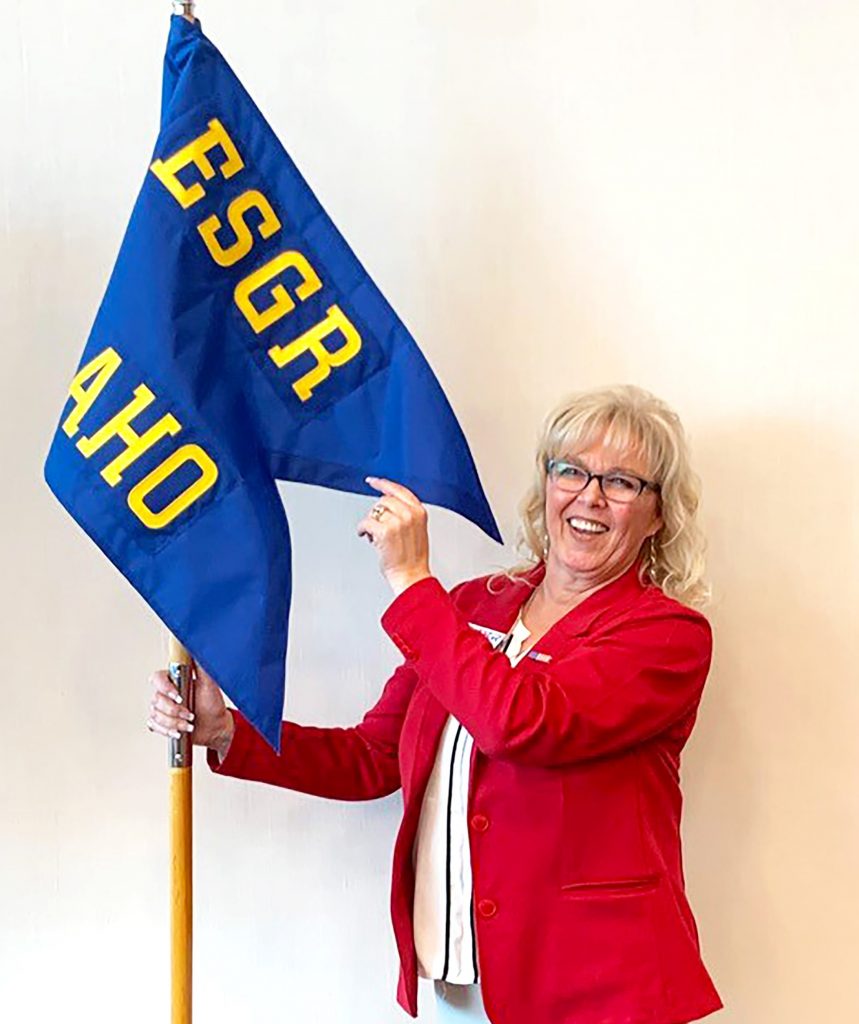
Before Cindy Reese joined the Employer Support of the Guard nearly 21 years ago, she participated in her first-ever employer outreach function, called a Bosslift, where she flew in a C130 to Fort Knox, Kentucky and visited with Soldiers.
She spent several days getting to know the Soldiers while living like one herself exploring tanks, eating in military dining facilities and shooting M16 rifles before returning to Idaho.
“After the other participants and I got off the plane and onto a bus, our event director asked us who had fun and was ready to go home,” said Reese. “Of course we all raised our hands. Then he asked us to take a moment and think of all those who didn’t get to come home from a deployment. There was not a dry eye on the bus. That’s when I decided I wanted to help make a difference and be part of something bigger than myself by joining the ESGR.”
Reese, who also works full time as a service manager for Tadd Jenkins Auto Group in Blackfoot, Idaho has since volunteered with the ESGR, helping to develop the program and relationships between Idaho National Guardsmen and their civilian employers.
She has held various positions including vice chair of the National Volunteer Support Subcommittee, which assists in the management, improvement and execution of ESGR volunteers, information technology and training programs.
Currently, she is serving her fifth year as the ESGR state chair of Idaho and in October, Reese was selected to serve as the National Volunteer Support Subcommittee chair.
For her service with the ESGR, Reese has received numerous awards including the Artillery Order of Molly Pitcher, the Seven Seals Award and the President’s Volunteer Service Award.
“ESGR is very near and dear to my heart,” said Reese. “The things our committee and I have been able to accomplish is because we have a great team, an incredible relationship with the military and we all have a true desire to be part of something more than ourselves. Many of our volunteers, like myself, did not serve in the military and this is our way to give back.”
About ESGR
ESGR is a Department of Defense program established in 1972 that promotes cooperation and understanding between reserve component service members and their civilian employers through outreach, recognition and educational opportunities.
The program operates through a network of more than 3,000 volunteers across 54 committees located in all 50 states, the District of Columbia, Guam, Puerto Rico and the U.S. Virgin Islands. Idaho’s ESGR Committee consists of more than 60 volunteers.
The Idaho National Guard helps to support ESGR and committee goals by promoting local employer outreach events such as Bosslift to build awareness of military missions while also recognizing civilian employers for their contributions and support to mission readiness.
Reese has contributed to more than two dozen state-wide and regional Bosslift events, in addition to other leadership and employer outreach events for organizations across the state, including chamber of commerce briefings.
Additionally, Reese has assisted the committee in recognizing hundreds of civilian employers throughout the state with various awards including the Secretary of Defense Employer Support Freedom Award, the Pro-Patria Award and the Above and Beyond Award.
“The support of our civilian employers is critical,” said Reese. “It’s been a real highlight of my career being able to recognize employers within our communities for that support by presenting them awards to let know how important they are to the success of our Guardsmen.”
In Feb. 2020, Idaho’s Adjutant General Maj. Gen. Michael Garshak, presented Reese and the Idaho ESGR committee, with their own guidon, recognizing the volunteers for their valuable contributions to the Idaho National Guard.
“Receiving the guidon meant a lot to us in the ESGR because it told us how important we are to the Idaho National Guard,” said Reese. “The ESGR would not be as successful as it is, if it were not for continued support of the Idaho Military Division leadership and the ESGR’s dedicated staff.”
“It’s always been about the people”
Reese had the opportunity to meet thousands of Guardsmen over the years, many who she now considers family. Much of the opportunities were life changing and strengthened her passion and commitment for volunteering, she said.
“They are the reason I volunteer,” said Reese. “It’s always been about the people. They are what keeps me going because I get to help make a difference in their lives and their families.”
In 2004, Reese visited Louisiana where thousands of Idaho Army National Guardsmen were conducting premobilization training prior to deploying. She served them Thanksgiving dinner and later shook their hands before they boarded a plane to Iraq.
“As I stood on the tarmac and shook hands with every single one of the thousands of Soldiers leaving, I remember seeing men and women, both young and old, with their backpacks and weapons,” said Reese. “Some had teddy bears and dolls given to them by loved ones. Some had tears in their eyes wondering if it was the last time they would see their families.”
Despite what those Soldiers left behind or sacrificed to deploy, Reese said their level of commitment to serve and do what they signed up for impressed her more than anything she had seen before. It was an once-in-a-lifetime opportunity that changed her, she added.
“The attitude and level of commitment those Soldiers portrayed that day changed the way I felt about the things I did in my own life,” said Reese. “It made me want to be more committed, dedicated and stand taller for the things I knew were right.”
In July 2019, Reese volunteered as chair of a committee that helped bring a replica of Washington D.C.’s Vietnam Veterans Memorial Wall to Blackfoot, Idaho. After the project completed two years later, “The Wall That Heals” opened for viewing during a ceremony in September 2021, where thousands of visitors attended.
Polish Land Forces attend Idaho National Guard tank training
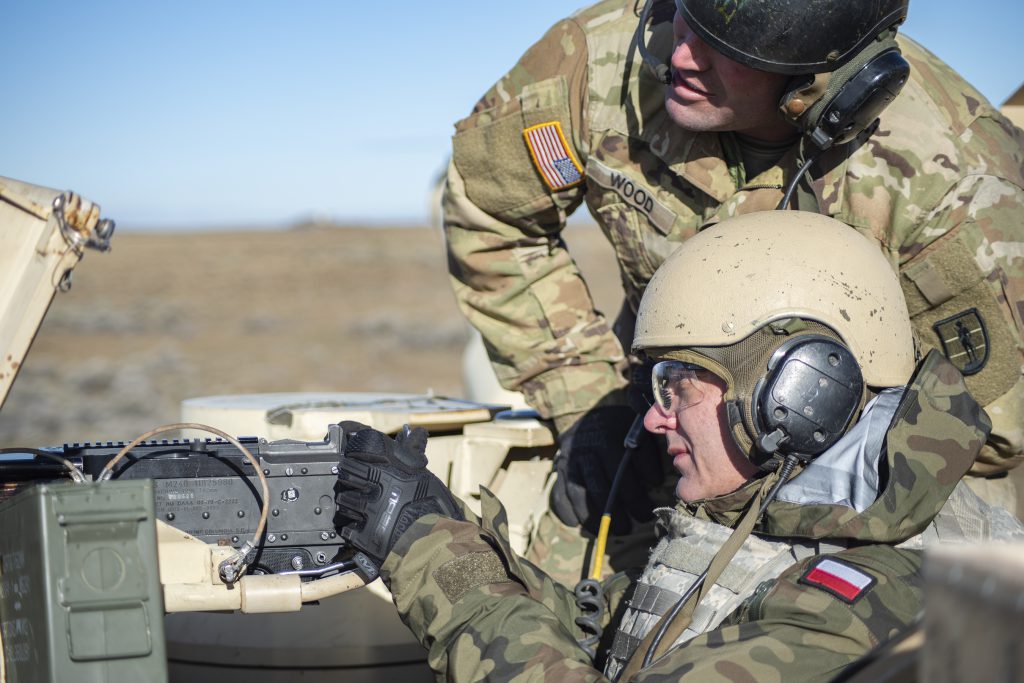
Crystal Farris/Idaho Military Division Public Affairs
Polish soldiers attended Idaho National Guard M1 Abrams tank training in October and November to share best practices on M1 Abrams training.
The Polish military—a U.S. ally, NATO member and official state partner of the Illinois National Guard—recently requested to purchase a fleet of M1A2 SEPv3 tanks and is working through the State Department and the Department of Defense to identify opportunities to partner in armor crew member training.
The Idaho Army National Guard’s 204th Regional Training Institute at Gowen Field trains U.S. military members in armor operation and tactics. During the visit, schoolhouse instructors and armor experts shared training and insights with the Polish.
“The 1st of the 204th Armored Training Battalion is the only National Guard battalion that teaches a full catalog of armored training courses,” said Maj. Noah Siple, commander. “We are credentialed to be the premiere armored training battalion of the National Guard. Couple that with our Orchard Combat Training Center and our ranges for armor-specific training, there is really no better place to go to.”
Polish officers and warrant officers serving in various positions including chief of planning and programming; logistician and fires experts; and company level officers, attended the battalion’s 19K transition course.
The battalion has provided armored training since the 1980s and offers various 19D and 19K courses, including a tank commander’s course and advanced leadership course. A portion of the curriculum requires students to train in the 143,000-acre OCTC, one of the country’s largest and most versatile maneuver training sites, located approximately 25 miles south of Boise.
Soldiers attending the course from the Idaho, Kansas, Oregon and Texas National Guards had the unique opportunity to interface with the Polish soldiers before graduating on Nov.22.
The 27-day course is designed for enlisted members in the ranks of sergeant and staff sergeant. The platoon-level coursework provides training in the technical and tactical skills necessary to employ the M1A1 or M1A2 SEP tank against enemy positions during unified land operations.
While Poland currently operates the T-72 and P-91 tanks, the M1A1 and M1A2 offers an array of operational differences and capabilities, said Sgt. 1st Class Lucas Kaserman, the 19K transition course manager.
“We integrated the Polish soldiers as much as possible into the training course to give them many of the same opportunities we give our U.S. students,” said Kaserman. “They already have a familiarity with tanks, which was helpful, however, the M1 is a different kind of tank with a lot of new things to learn.”
Throughout the course, Polish members took turns rotating through the driver, loader, gunner and commander crew stations; participated in tank simulators where they operated as both tank commander and gunner while engaging simulated targets; and conducted live-fire familiarization in the OCTC, where they fired different weapon systems of the tank, including an M240 and .50 caliber machine gun.
Additionally, they spent time with course experts and senior leaders of the Idaho Army National Guard, including its 116th Cavalry Brigade Combat Team, an M1 tank unit.
“They came here to experience first-hand training with the M1A2V2 Abrams tank and to understand how we train and construct courses for Soldiers becoming tankers in the U.S. military,” said Siple. “They also got to engage and build relationships with all elements of the Idaho Army National Guard.”
In November, senior leaders from the Polish Land Forces and Illinois National Guard visited Idaho to observe course training and what the 1-204th RTI has to offer. The visitors had the opportunity to tour some of the Idaho Army National Guard’s facilities, equipment and its premiere OCTC, in addition to engaging with Idaho’s leadership and armor experts.
The Illinois National Guard and Republic of Poland enjoy an enduring State Partnership Program focused on professional military education, crisis management and response as well as operational combat and deployment training. The partnership began in 1993 just after Poland emerged from behind the USSR’s Iron Curtain. Poland was accepted as a full NATO ally in 1999. Polish and Illinois National Guard soldiers co-deployed first to Iraq and then to Afghanistan from 2003 to 2020.
The Illinois National Guard does not operate or maintain the M1 tank and helped facilitate the co-training with Idaho.
The Nez Perce Tribe and Idaho National Guard work together during COVID-19
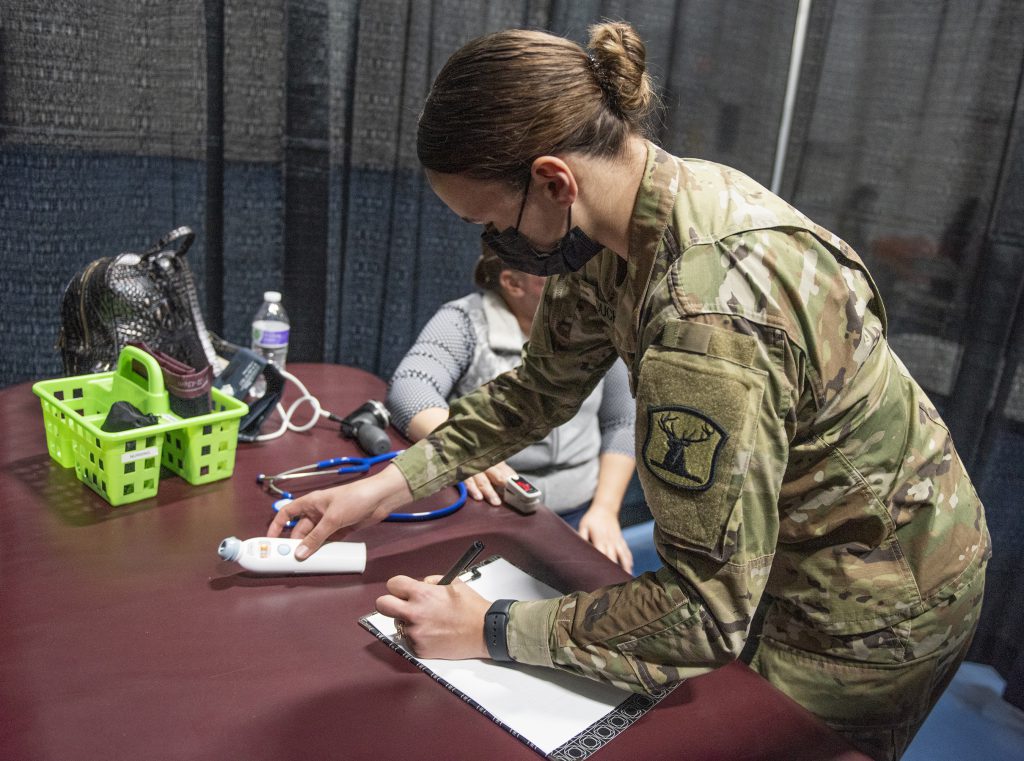
Master Sgt. Becky Vanshur/Idaho Military Division Public Affairs
Nez Perce Reservation, IDAHO – Idaho National Guard and Nez Perce dental personnel teamed up Nov. 10 – 13 as part of a larger effort to recover from the summer’s surge of COVID-19 cases plaguing northern Idaho.
The Nez Perce Tribe and the Idaho National Guard are working together through a program known as Innovative Readiness Training to help the Nez Perce community’s healthcare system recover after becoming backlogged during a community-wide shut down earlier this year. The dental visit was part of a larger medical effort taking place between the tribe and the Idaho National Guard.
“Idaho National Guard members are driven by a sense of purpose,” said Maj. Gen. Michael Garshak, the adjutant general of Idaho. “IRT collaboration like this not only enables us to sharpen our military skills, but it also provides great opportunities to make positive impacts to the communities of Idaho and a difference in the lives of our fellow citizens.”
The Nez Perce tribe submitted a collaborative IRT application earlier this summer to request assistance in addressing their overwhelmed medical staff resulting from the second wave of COVID-19 cases. The Idaho National Guard responded by sending medical and dental citizen-Soldiers and Airmen performing three missions—a two-part diabetic IRT in June and October, a medical IRT in August and most recently the dental IRT in November, which resulted in dental screenings of nearly 250 Nez Perce school-aged children. Activities also included helping local clinics complete high school sports physicals and preschool Head Start program physical exams before the start of sports season and the school year.
“Working with their local health care personnel helps us build relationships with the tribes while training our Idaho National Guard medical personnel,” said Lt. Col. Tina Williams, an occupational health nurse for the Idaho Army National Guard. “Our mission is to help the Nez Perce community catch up on a backlog of patients while providing Guardsmen relevant training and a unique experience by seeing both adults and children at the Nez Perce clinics.”
Idaho National Guard personnel also assisted tribe clinicians at two large COVID-19 vaccination clinics located at Lapwai and Kamiah.
“The National Guard has helped us with several projects throughout the pandemic,” said Roxie Kim Hartwig, M.D. at Nimiipuu Health with the Nez Perce Tribe. “One of our mass vaccination events would have been impossible without the Idaho National Guard. The purpose of the diabetic IRT is to help us catch up with care that has been delayed due to the pandemic and provides training for the National Guard medical staff to gain some practical knowledge about our medical application.”
Williams said the Nez Perce staff was thankful for the Idaho National Guard’s timely assistance with the diabetic clinics, sports physicals and dental exams as the tribe is beginning to see another increase in COVID-19 screenings.
Idaho Army National Guard deploys to Southwest Asia
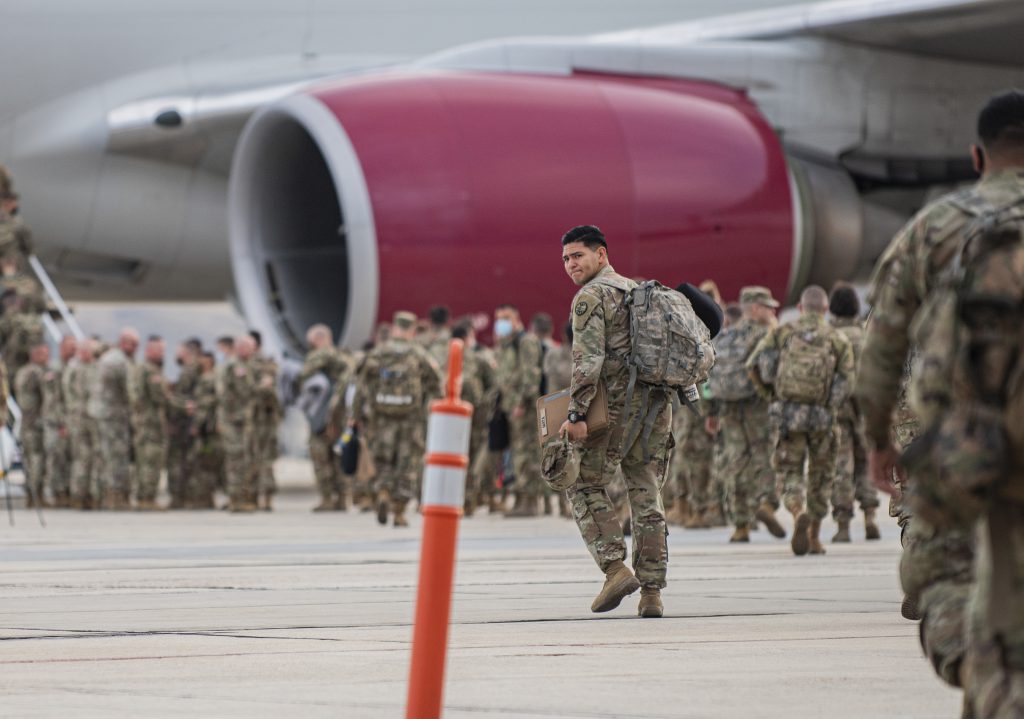
More than 250 Soldiers from the Idaho National Guard’s largest unit, the 116th Cavalry Brigade Combat Team, left for a 12-month deployment on Nov. 5 to Southwest Asia in support of Operation Spartan Shield. The brigade has trained for more than a year in anticipation of this mobilization.
OSS is a joint mission under the United States Central Command and is part of Operation Enduring Freedom. Idaho Soldiers will comprise nearly 20 percent of the 116th CBCT task force during this rotation. Soldiers from 116th CBCT units in Montana, Nevada and Oregon, as well as the Florida Army National Guard, will also fall under the task force.
“The Soldiers of the 116th are trained and ready to go,” said Lt. Col. Eric Orcutt, 116th CBCT commander. “I could not be more proud of these men and women and the efforts they’ve put forth in training and preparing for this mission. They are eager and they are focused and as always, they will achieve the highest level of success.”
OSS is an ongoing operation and supported primarily by Army National Guard units from across the country. This deployment is anticipated to last approximately 12 months and is the first rotation the brigade is scheduled to support, with the second rotation occurring in the summer of 2022. The Soldiers mobilizing today will receive 45 days of additional training stateside before deploying overseas.
The 116th Cavalry Brigade Combat Team previously deployed in support of the Global War on Terror in 2004 and 2010 to Iraq. Additionally, more than 400 Idaho Air National Guardsmen deployed to Southwest Asia in the summer of 2020.
COVID response prompts Idaho National Guard to establish first dual-status commander
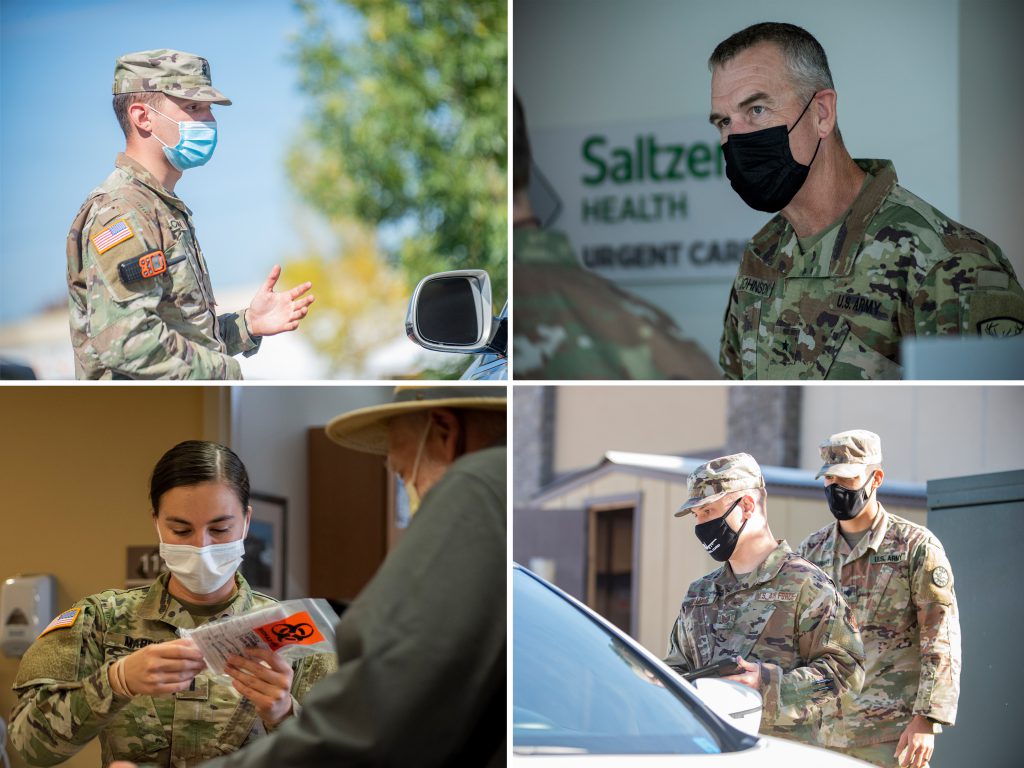
Idaho Military Division Public Affairs/Crystal Farris
In September, after a second wave of COVID-19 cases spread across Idaho, Gov. Brad Little authorized the mobilization of up to 150 Idaho National Guard Soldiers and Airmen. He also requested additional federal support as a last-ditch effort to avoid activating a statewide crisis standards of care—a first in Idaho’s history.
On Sept. 7, at the recommendation of Gov. Little and the Adjutant General of Idaho Maj. Gen. Michael Garshak, U.S. Northern Command appointed Brig. Gen. Russ Johnson, Idaho National Guard director of joint staff, as the state’s first-ever dual-status commander. That same day, Idaho Guardsmen and federal active duty military personnel began reporting to hospitals, clinics and other medical facilities across the state in support of overwhelmed medical staff.
“Joint Task Force – Idaho is helping free up civilian medical staff allowing them to focus on providing medical care during the ongoing surge in COVID-19 cases,” said Johnson. “Collectively, our Title 32 Idaho National Guardsmen and Title 10 active duty personnel are employed in direct support of our healthcare sector, making a difference in the lives of Idaho citizens every day.”
Currently, Idaho National Guardsmen are serving at nearly two-dozen healthcare facilities across the state performing non-clinical duties including medical screenings, testing collection, logistics assistance and other administrative tasks.
Idaho National Guard Col. Britt Vanshur, chief of the joint staff, said the Idaho National Guard provides support in administrative functions rather than playing a clinical role, since the majority of its medical professionals are part-time Guardsmen already working full time at hospitals, clinics and healthcare facilities.
“It would be imprudent to pull our Idaho Guard medical personnel from their civilian capacities at these healthcare facilities just to activate and send them back in uniform to perform these same tasks,” said Vanshur. “They’re already making a positive impact on the health districts in their civilian capacity.”
This activation marks the second time since the beginning of the pandemic that Idaho National Guardsmen have deployed in response to COVID-19. In March 2020, the Idaho National Guard began mobilizing more than 400 citizen-Soldiers and Airmen as part of the organization’s first COVID-19 relief effort, named Task Force Agile Response.
During this second wave, while record numbers of COVID-19 cases overwhelmed northern Idaho, Kootenai Health requested assistance through the Idaho Office of Emergency Management as the hospital’s capability reached its limits, forcing it to implement emergency standards of care.
In response to this request, the Department of Defense, through U.S. Northern Command, allocated a U.S. Army medical response team. The 23-person MRT is augmenting Kootenai Health by providing doctors, nurses and respiratory therapists from various commands and locations, including Fort Carson, Colorado and Joint Base Lewis-McChord, Washington.
This is the first time in Idaho history that Title 32 and Title 10 personnel have mobilized under one joint task force creating the demand for a dual-status commander to effectively coordinate response efforts between both forces.
“Dual-status command effectively streamlines National Guard and active component efforts under a single commander in support of state and federal civil authorities,” said Johnson. “It ensures we all pull in the same direction to meet the needs—current and emerging—of the governor and his emergency management leadership.”
Idaho is one of several states to recently activate a dual-status commander for COVID-19 response. Other states include Alabama, Mississippi, Louisiana and Tennessee.
Members of Joint Task Force – Idaho have collectively worked thousands of hours since September, while providing care to COVID-19 patients and much-needed relief to overworked healthcare facility staffs.
“Idaho’s joint task force has been highly successful on many fronts,” said Johnson. “Our Guardsmen and active duty counterparts have put their personal lives on hold to come together and answer the call of fellow citizens during this historic pandemic.”
Idaho National Guard sends first wildland firefighting crew to northern Idaho
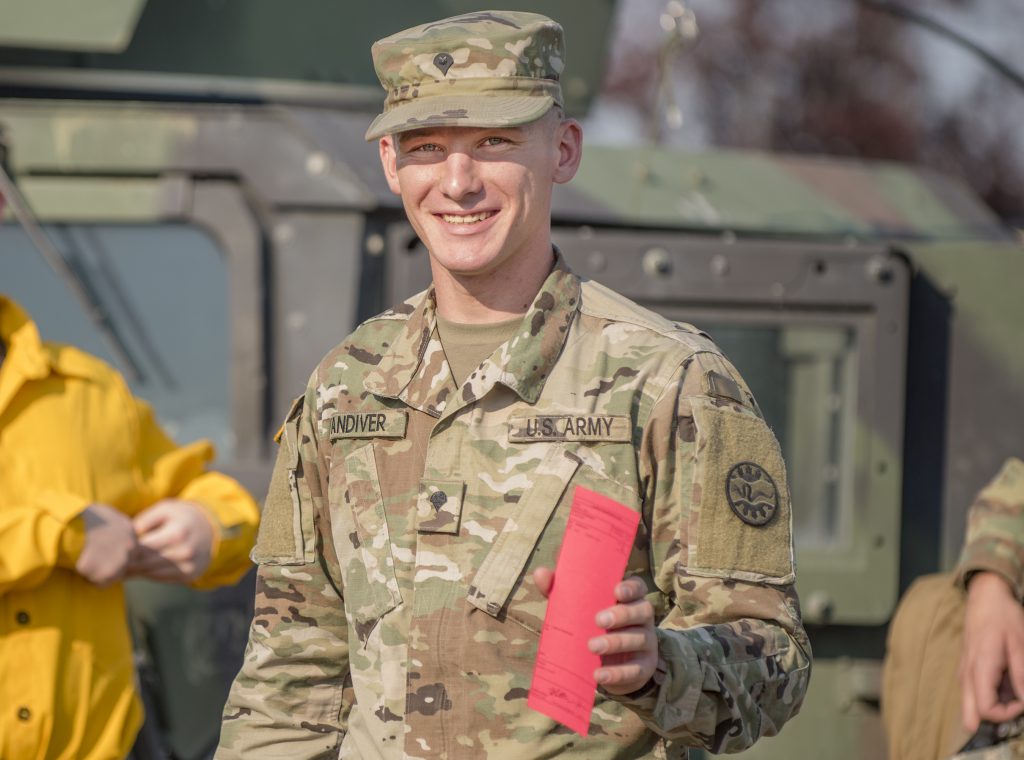
Idaho Military Division Public Affairs/Master Sgt. Becky Vanshur
Idaho National Guard Soldiers and Airmen made organizational history by sending wildland Firefighter Type 2 Red Card certified Guardsmen to northern Idaho to fight fires for the first time. The newly assigned crewmembers of the Task Force Timber Shield left Boise Aug. 4 to assist the Idaho Department of Lands’ mission of containing more than 15 significant wildland fires currently burning in Idaho.
It is the first time the IDL requested Idaho Gov. Brad Little to issue an emergency declaration for making Idaho National Guard resources available to assist fighting against fires on the ground. For some Guardsmen, the volunteer notice came early in July and they immediately began training to earn their FFT2 Incident Qualification Cards, commonly known as a Red Card certification.
“I made sure my name was on that list when I heard the call for volunteers,” said 2nd Lt. Travis Stice. “It will be hard, physical labor, which I am excited for. I told my son that I was going to leave to go fight fires and he said, ‘but you are in the Army, you’re not a firefighter,’ and I said, ‘We do everything, buddy.’”
Stice is one of 72 Guardsmen who has earned his Red Card and more personnel are currently completing the training in anticipation of additional missions. He joined the Idaho National Guard four years ago and this is his first State Active Duty mission as a Guardsman.
“I am very excited that this is a state mission,” Stice said. “It’s the reason I signed up for the Idaho National Guard, to help the citizens of Idaho, along with serving my country. I just love my fellow Idahoans. I called my employer with one day’s notice and they said ‘awesome, just come back safe and we’ll work everything out when you come back.’ They were very supportive even with the short notice.”
The additional training for more Red Card certified Guardsmen stemmed after the governor issued the emergency declaration July 9 to mobilize Idaho National Guard fire line FFT2 qualified personnel to work on active wildfire efforts on the 6.2 million acres of land across mostly northern Idaho where IDL provides fire protection.
The FFT2 crew consists of sixteen fully trained Idaho Guardsmen. The IDL provided one crew boss and two squad bosses to complete a full nineteen-man crew.
“We are currently training more Soldiers and Airmen as they volunteer for this mission in the hopes of building a large capacity consisting of several hand crews,” said Lt. Col. Tony Vincelli, commander of Task Force Timber Shield. “This is the kind of mission that makes serving in the National Guard so unique and rewarding. I hope Soldiers and Airmen see how rewarding this mission is and truly understand the impact they could have.”
The Guardsmen were issued firefighting personal protective equipment, fire-resistant clothing, hand tools and sleeping accommodations just prior to leaving.
“The boots on the ground, physical labor of this kind of work is different than anything I have ever done in my career,” said Maj. Robin Kiska, from the 224th Cyber Operations Squadron, Idaho Air National Guard. “It’s like an extreme hiking adventure in extreme conditions. It will be hard work but a welcomed challenge.”
The governor’s emergency declaration also authorized other personnel to support fire logistic activities and make National Guard aircraft resources available.
Currently, the Idaho National Guard has two UH-60 Black Hawk helicopters and pilots, crew chiefs, refueling crew and essential maintenance personnel assisting with aerial firefighting by delivering water using large capacity “Bambi Buckets,” or helicopter buckets, suspended from helicopter cables. The UH-60 Black Hawk crews have been assisting Idaho’s mission this fire season since July 13 and have dropped more than 187,096 gallons of water on several fires.
Additionally, a request for help at the Idaho Fire Cache warehouse in Coeur d’Alene sent eight Guardsmen on July 21 to provide logistical and operational support of daily refurbishment operation to include palletizing orders, building kits, cleaning, repackaging firefighting hoses and pulling stock of supplies and equipment for state and federal wildland firefighters.
The IDL, the Idaho Office of Emergency Management and the Idaho National Guard developed a partnership a few years ago through a Joint Powers Agreement, defining the process involved in interagency coordination, support, training and planning during times of emergency involving mutual aid of wildland fire relief within Idaho.
“Today marked yet another milestone in the proud history of the Idaho National Guard as wildland firefighter ground crews mobilized and deployed to support the growing wildland fire threats across our state,” said Brig. Gen. Russ Johnson, director of the Idaho National Guard Joint Staff. “Our National Guard service members – and their families – have again answered the call to support the citizens of Idaho during this volatile fire season.”
Currently, around the country more than 770 National Guard Soldiers and Airmen from eight states are assisting with fighting wildland fires. Four UH-60 Black Hawks, two CH-47 Chinooks and one UH-72 Lakota are supporting aviation wildfire operations across the nation. Four C-130 crews are in California, Nevada and Wyoming equipped with Modular Airborne Fire Fighting Systems. To date, National Guard MAFFS crews have made 357 drops and flown 366 sorties in support of the fires across the United States. The National Interagency Fire Center reports over 38,200 fires have burned a total of 3.2 million acres across 14 states.
Idaho Army National Guard participates in new smart weapon training
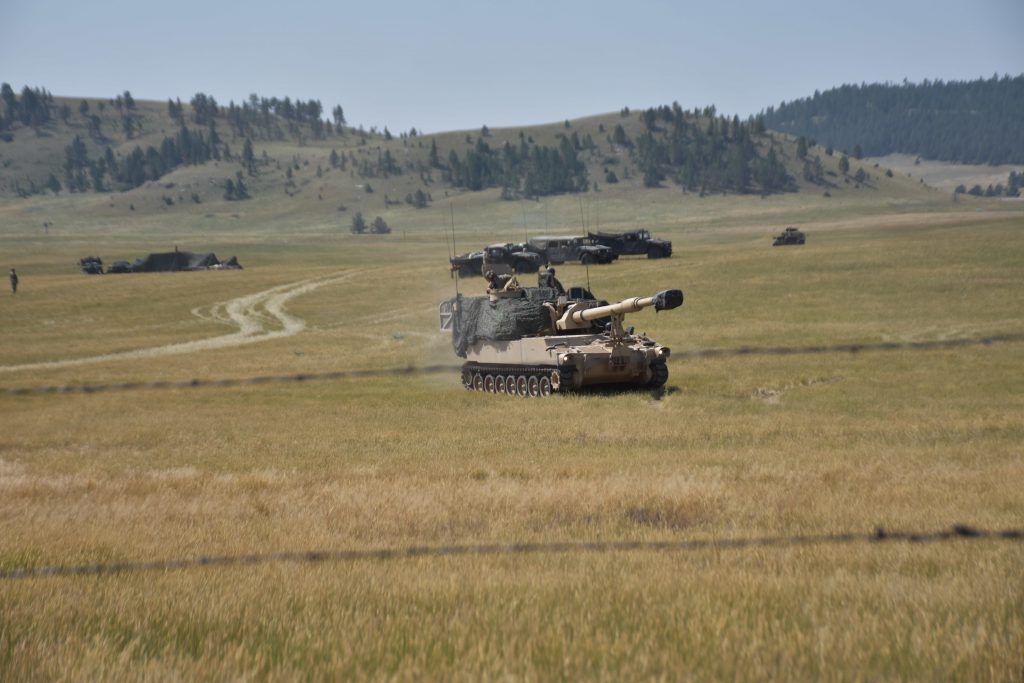
Idaho Military Division Public Affairs/Crystal Farris
The Idaho Army National Guard’s 1st Battalion of the 148th Field Artillery Regiment returned from its annual training July 24, after spending more than two weeks at Camp Guernsey, Wyoming, where it participated in its first M1156 Precision Guidance Kit new equipment training.
“Receiving the PGK NET was a great opportunity that will enhance the battalion and the 116th Cavalry Brigade Combat Team’s lethality on the battlefield,” said Lt. Col. Eric Orcutt, commander of the 1-148th FAR. “We purposely sought to field the PGK prior to the brigade’s upcoming mobilizations. If the PGK capability exists in the theater of operations we end up in, then our Soldiers will be trained to employ it and bring a precision capability to the fight.”
The GPS guidance kit with fuze functions and integrated GPS receiver, provides the 1-148th FAR with the latest technology to perform its warfighting mission and enables the unit to more accurately deploy munitions within 30 meters of an intended target, as opposed to the average 50 meters of traditional artillery.
Small aerodynamic fins on the fuze allow the system to make flight adjustments of the round’s trajectory and steer the shell on target. A fail safe can also prevent the shell from exploding if it falls outside 150 meters of an intended target.
This enables Soldiers to more confidently call in artillery support close to their position, reduce the number of shells needed to destroy a target and reduce difficulties in keeping crews supplied, said Sgt. 1st Class Mike Taylor, master gunner with the 1-148th FAR.
The fuze kit weighs three pounds and threads into the nose of conventional 155mm high explosive artillery shells, providing near-precision capabilities at a cost far less than precision munitions, Taylor added.
During the training, Soldiers belonging to Batteries Alpha, Bravo and Charlie learned about the PGK’s capabilities and conducted live-fire for the first time since the 1-148th FAR completed its National Training Center rotation at Fort Irwin, California, in 2019.
Orcutt said Camp Guernsey provided the battalion the ability to effectively train and conduct live-fire with more than 10 kilometers of open land.
“The 1-148 FAR was excited for the training at Camp Guernsey,” he said. “After last year’s annual training during COVID-19, everyone was eager to get back on the guns, on the hill, behind their fire direction computers, or wherever their job is. The training area was wooded, green, and full of terrain that many have not had an opportunity to experience, keeping the morale high and the training challenging.”
The 1-148th FAR employs fire to destroy, neutralize, suppress or shape enemy forces; provides fire support to maneuver in close combat and during counterattack to control land areas; and provides counterfire.
It is equipped with M1096A6 Paladins, self-propelled howitzers that fire 155mm artillery shells. Crews that operate the Paladin consist of four-man teams; a driver, a number one man, a gunner and a howitzer section chief.
The number one man is responsible for loading and firing the howitzer, the gunner fuzes the round and cuts propellant powder, while the section chief manages all firing data and ensures the howitzer is laid on target.
Challenge accepted: from Youth ChalleNGe to Soldier
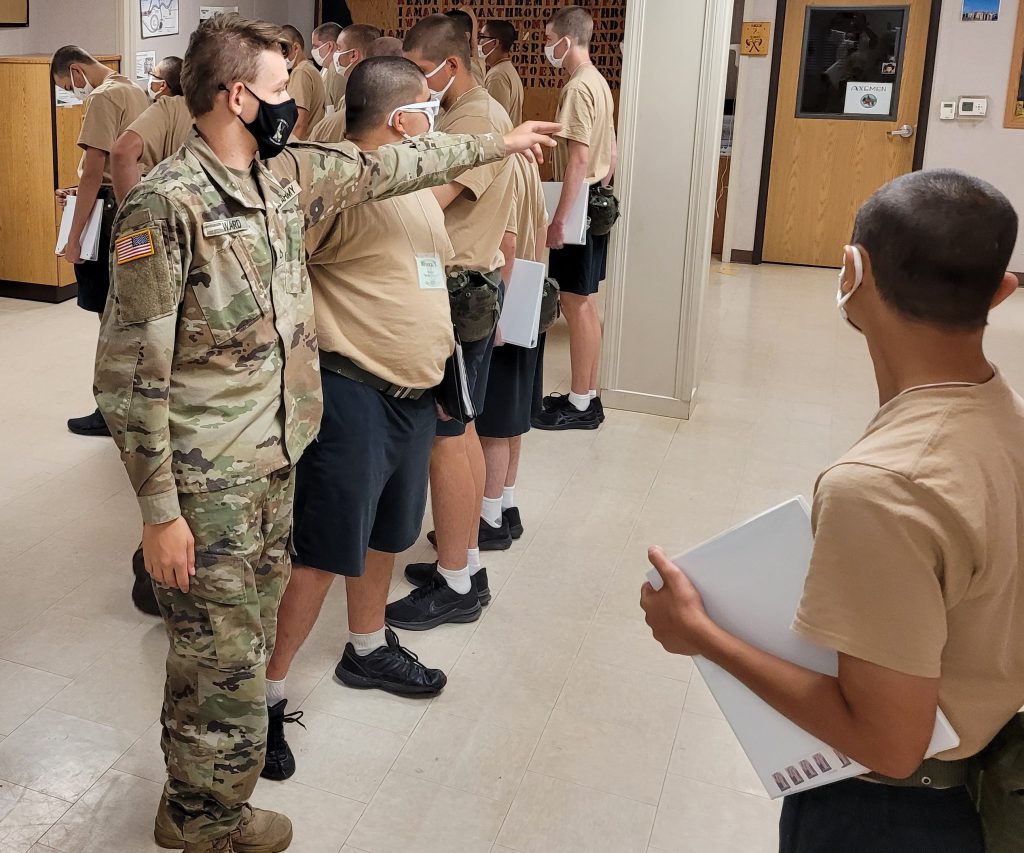
Idaho Military Division Public Affairs/Maj. Robert Taylor
The Idaho Youth Challenge Academy’s newest class of candidates is currently going through a two-week acclimation phase. During this phase, candidates are challenged to adapt to the program’s rigid schedule, strict rules and culture of personal accountability.
The academy conducts two classes each year. Idaho National Guard Soldiers and Airmen volunteer to supplement the academy’s full-time cadre to assist during its first phase in a state active duty status.
For most of the Soldiers and Airmen, this rotation is their first experience with the Youth ChalleNGe, though some Guardsmen have supported multiple acclimation periods at the academy.
For Pfc. Riley Ward, this semester’s rotation is his first as a cadre member, but he has extensive knowledge of the program’s goals and procedures. Ward graduated from the program as a cadet in 2018.
“When I graduated, I felt like it was just a matter of time before I came back in an U.S. Army uniform,” Ward said.
Ward enlisted into the Idaho Army National Guard in 2019 when he was 17. Though the academy offers cadets the chance to earn up to 14 high school credits; a diploma from the school; or a GED, Ward said he dropped out of high school shortly after returning home from the academy and earned his GED on his own.
Every cadet is paired with a mentor while they complete the 22-week residential phase. Ward’s mentor was Col. Dan Lister, the Idaho Army National Guard’s chief information officer and director of information management. Ward said Lister told him about the Idaho Army National Guard and the organization’s benefits.
“I liked the structure of the Youth ChalleNGe,” Ward said. “I figured it’d been stupid not to enlist since I thrived in that environment.”
Ward is a 25B information technology specialist assigned to Company Charlie, 116th Brigade Engineer Battalion. Ward lives in Nampa and drills in Boise at Gowen Field. Though Lister is the Idaho Army National Guard’s senior IT officer, it was Ward’s love of technology that drove him toward the same career field as his mentor.
“When I was six, my dad sat me in front of an old Windows computer, and I fell in love with technology then,” he said. “It’s always been a passion. I figured I might as well do something I enjoy while I’m in the Army.”
Ward said he has received a lot of training in his career field and that he’s never had a bad day in the Army. He plans to attend college and work his way up to his dream job: the head of network security for Dell Technology.
Ward said he attended the academy after a series of behavioral issues got him in trouble with his parents.
“I was a piece of crap to my parents, and they had enough, so they sent me here,” he said.
Ward acknowledged he was doing things at the time he shouldn’t have been doing, though he was never charged with any crimes.
“I learned discipline at the academy,” he said. “That’s all I really needed. I knew what the right thing to do was, I just didn’t feel like doing it. I realized to be successful, I couldn’t be in trouble with the law. These are basic things everyone knows, but I refused to do.”
Since 2014, more than 1,300 students from nearly every county in Idaho have attended the academy. The program is free for 16- to 18-year-old-students who are at risk of dropping out of high school or who already have. Cadets attend a 22-week residential program in Pierce, Idaho, and remain part of the program for the following 12 months to ensure students remain on track to continue their education or find employment.
There are 40 Youth ChalleNGe academies throughout the country, which are run by each state’s National Guard.
Nearly 80 percent of the Idaho Youth ChalleNGe Academy’s cadets return to their high school back on track to gradate with their class after completing the residential program. Another 10 percent earn their GED, while the remaining 10 percent earn enough credits to graduate from the academy with a high school diploma. Approximately 10 percent of the program’s graduates have joined the military, though the academy is not a military school and military service is not a requirement for attendance.
“Since I did exactly what they are doing now, I have a better feeling of what candidates are going through as they adjust to the academy,” Ward said. “A lot of them are coming off stuff and are in a new environment. I know exactly what that feels like. I feel more equipped to help them with whatever they need to do.”
Idaho National Guard memorializes WWII Medal of Honor recipient
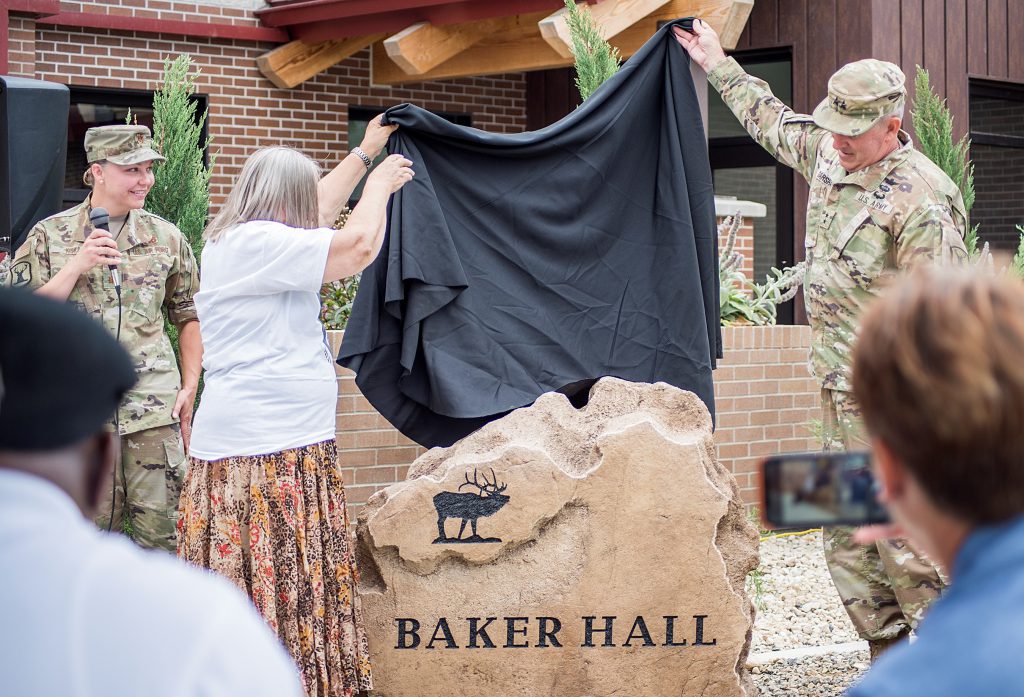
Idaho Military Division Public Affairs/Crystal Farris
The Idaho National Guard dedicated its newest barracks in honor of Medal of Honor recipient U.S. Army 1st Lt. Vernon Joseph Baker on Gowen Field, Tuesday.
Baker was one of seven African Americans awarded the Medal of Honor for service during World War II. He received the award nearly 50 years later for his extraordinary heroism on April 5 and 6, 1945, while in Viareggio, Italy. The award is the nation’s highest and most prestigious military decoration.
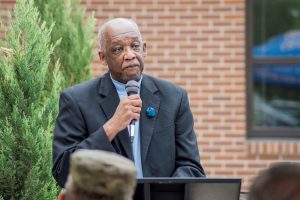 “I’m thankful that on this day, we will create a lasting legacy in the name of 1st Lt. Vernon J. Baker, Medal of Honor recipient,” said Jerome Mapp, former Boise City Council member and Caldwell planning and zoning director. “Those who will enter into this building will have the opportunity to learn about Baker, his leadership and the sacrifices he made.”
“I’m thankful that on this day, we will create a lasting legacy in the name of 1st Lt. Vernon J. Baker, Medal of Honor recipient,” said Jerome Mapp, former Boise City Council member and Caldwell planning and zoning director. “Those who will enter into this building will have the opportunity to learn about Baker, his leadership and the sacrifices he made.”
Baker joined the Army in 1941 and later attended Officer Candidate School to earn his commission as a second lieutenant in 1943. The following year, he deployed with the 92nd Infantry Division to Italy. On April 5, 1945, Baker led 25 African American infantrymen through a maze of German bunkers and machine gun nests to attack Castle Aghnolfi, a German stronghold.
He lost 17 of his men during the battle. However, Baker destroyed various enemy installations, personnel and equipment during the attack. The next night, he volunteered to continue the advancement of a battalion through further enemy minefields and heavy fire.
Baker earned the Distinguished Service Cross for his actions, the Army’s second-highest award for bravery.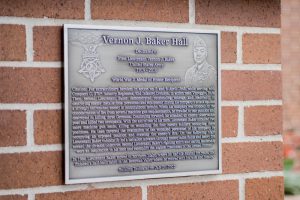
In the early 1990’s the Department of Defense and the U.S. Army initiated an investigation that determined a climate of racism had prevented African American service members from receiving proper recognition for acts of courage during World War II. In total, seven African Americans, including Baker, were later approved to receive the Medal of Honor.
Baker was the lone survivor of those seven individuals on Jan. 13, 1997, and the only African American to ever personally receive the award for service in World War II, when he accepted the Medal of Honor from President Bill Clinton at a ceremony in the White House. He was 77 at the time.
After Baker retired from the service in 1986, he moved to Idaho to pursue his love of hunting. He later met his wife Heidy, who he lived with in their St. Maries home until Baker’s death in 2010 when he was interred at the Arlington National Cemetery in Virginia.
Mapp said in 2020 he had wanted to recognize an African American from Idaho and remembered meeting Baker in 2000 during an event at the Idaho Black History Museum. Mapp thought Baker was worthy of recognition as an Idaho citizen and Medal of Honor recipient and requested he be memorialized by the Idaho National Guard.
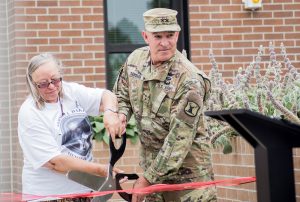 Maj. Gen. Michael Garshak, adjutant general of Idaho, said the organization wanted to honor Baker in a lasting way, where other service members could benefit from Baker’s accomplishments.
Maj. Gen. Michael Garshak, adjutant general of Idaho, said the organization wanted to honor Baker in a lasting way, where other service members could benefit from Baker’s accomplishments.
“Vernon Baker is a genuine American Hero,” said Garshak. “Not only for his heroic actions on the battlefield in World War II, for which he was awarded the Medal of Honor, but also because of his unfailing determination to put honor and country above all else.”
Construction of the barracks started in April 2020 and took three years and approximately $8 million to complete. It provides temporary lodging for up to 156 personnel with 39 private rooms and a shared dayroom.
It is the first building on Gowen Field to earn a gold certification in Leadership in Energy and Environmental Design; the second highest rating of four certifications that verify a facility’s green features. The Vernon J. Baker Hall earned its LEED rating through various features including integrated ground loop heating and cooling systems, low flow fixtures, sustainable building practices and sustainable landscape features.
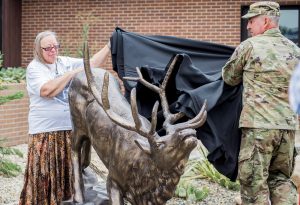 Heidy, who still lives in St. Maries, spent the night in the barracks prior to the dedication.
Heidy, who still lives in St. Maries, spent the night in the barracks prior to the dedication.
“It’s wonderful to have this building dedicated to my husband and a great honor for our family,” she said.
Outside the barracks is a stone that reads “Baker Hall,” a statue of an elk symbolizing Baker’s love for hunting in Idaho, and a plaque embedded into the bricks of the building entrance. Inside the building is his Medal of Honor citation and a brief history and biography of Baker.
We owe him everything we’ve got… and then some.
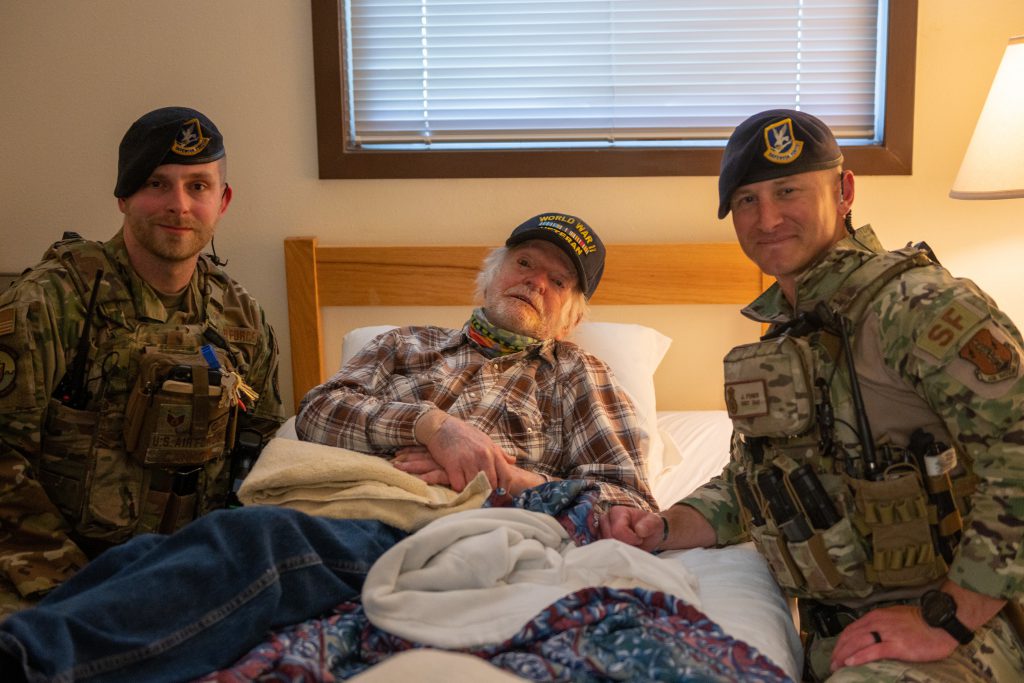
124th Fighter Wing Public Affairs/Staff. Sgt. Mercedee Wilds
124th Security Forces Squadron defenders went above and beyond to assist a 96-year-old World War II veteran.
Retired Capt. William Brand was a P-47 Thunderbolt pilot with the Eighth Air Force in Okinawa, Japan, during WWII. He now lives in Hailey, Idaho, but regularly travels to Gowen Field in Boise, Idaho to stay at the on-base lodging on days that he has appointments at the Boise VA Medical Center.
On May 6, 2021, 124th SFS defenders received an emergency call to the Gowen Field Lodging Facility. As Brand was checking in for a routine stay at the Gowen Field Lodging Facility he experienced a medical emergency, which left this WWII veteran with special requirements and a limited ability to properly care for himself and coordinate his VA appointments.
124th SFS defenders took it upon themselves to organize hourly shifts to check on the well-being of Brand, which included assisting with tasks of daily-living, providing essential needs and helping to coordinate with the VA for medical attention.
The defenders took on the role of dedicated care-givers, going beyond their typical duty and surpassing their daily requirements. To this group of 124th SFS members, it was an honor to help Brand and learn about his service to our country.
“Helping a veteran isn’t in our book for normal tasks, but it’s a sense of honor to help someone like that, who not only served our country but spent time in a war that we are still benefiting from,” said Staff Sgt. Jonathan Finer, a 124th SFS member.
Finer and the other defenders who helped Brand felt providing help and assistance to him, a brother in arms who dedicated so much of his life to protecting our country, was the least they could do.
“It’s an honor to be able to hear the stories from the direct mouth of someone who has experienced it,” said Finer, “my personal feelings are that we owe him everything we’ve got and then some.”
 Official Government Website
Official Government Website